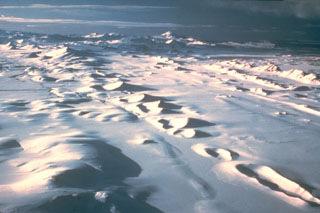Report on Bardarbunga (Iceland) — 20 August-26 August 2014
Smithsonian Institution / US Geological Survey
Weekly Volcanic Activity Report, 20 August-26 August 2014
Managing Editor: Sally Sennert.
Please cite this report as:
Global Volcanism Program, 2014. Report on Bardarbunga (Iceland) (Sennert, S, ed.). Weekly Volcanic Activity Report, 20 August-26 August 2014. Smithsonian Institution and US Geological Survey.
Bardarbunga
Iceland
64.633°N, 17.516°W; summit elev. 2000 m
All times are local (unless otherwise noted)
During 20-26 August the Icelandic Met Office reported ongoing high rates of seismic activity at Bárdarbunga volcano. Global Postioning System and seismic data indicated that an intrusive dike had increased from 25 to 40 km in length E, NE, and N of the volcano over the past week. During 22-26 August several earthquakes in the 4.7-5.7 magnitude range had been detected at or near the volcano. On 23 August seismic tremor indicated a small lava-eruption 150-400 m beneath the Dyngjujökull glacier, prompting a change in the Aviation Color Code to Red. On 24 August observations from an overflight indicated there was no eruption and the Aviation Color Code was changed to Orange. On 26 August the location of the seismicity was located primarily along the 10 km long tip of the dike that extended 5 km beyond the glacier margin.
Geological Summary. The large central volcano of Bárðarbunga lies beneath the NW part of the Vatnajökull icecap, NW of Grímsvötn volcano, and contains a subglacial 700-m-deep caldera. Related fissure systems include the Veidivötn and Trollagigar fissures, which extend about 100 km SW to near Torfajökull volcano and 50 km NE to near Askja volcano, respectively. Voluminous fissure eruptions, including one at Thjorsarhraun, which produced the largest known Holocene lava flow on Earth with a volume of more than 21 km3, have occurred throughout the Holocene into historical time from the Veidivötn fissure system. The last major eruption of Veidivötn, in 1477, also produced a large tephra deposit. The subglacial Loki-Fögrufjöll volcanic system to the SW is also part of the Bárðarbunga volcanic system and contains two subglacial ridges extending from the largely subglacial Hamarinn central volcano; the Loki ridge trends to the NE and the Fögrufjöll ridge to the SW. Jökulhlaups (glacier-outburst floods) from eruptions at Bárðarbunga potentially affect drainages in all directions.

